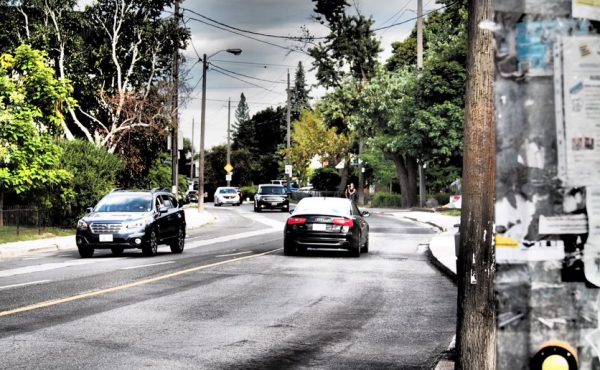
It’s been a while since I sat in on the City of Toronto Public Works and Infrastructure Committee, but I went there last Tuesday to depute in favour of the City of Toronto’s new Walking Strategy.
I had forgotten how surreal city Committees can be. The day featured grandstanding, tangents, diversions, confusion and the periodic appearance of Denzil Minnan-Wong in his role as the Caped Car Crusader (well, he wasn’t actually caped, but he might as well have been).
I arrived as the committee was hearing deputations on the proposals to improve the streetscape of Roncesvalles. The city is proposing to take advantage of the fact that the street needs to be torn up for water projects and streetcar track rebuilding to create more room for pedestrians and sidewalk amenities by creating “bump-outs” at some corners and widening sidewalks in one or two places, which they can achieve by turning the current curb lanes used mainly for parking into parking bays. Very few parking spots will be lost — but despite the fact that there will still be about 220 parking spaces and the peak observed demand for parking was only 197 spaces, local residents still showed up to complain about the loss of parking spaces. One woman said that some of the parking was several blocks from where the peak demand was — presumably a few minute’s walk is simply too inconvenient.
I was impressed, though, that representatives from the Roncesvalles BIA and from local resident’s associations came to strongly support the proposals. One group of local residents, to alleviate parking concerns, did a “parking convenience study” where they counted parked cars on 21 different occasions. They didn’t just count total cars and parking spaces, either — they specifically looked to see if there was parking available within a block in the busiest parts of the street. They discovered that there were always some parking spots available within a block of any particular location, even at peak times. Maybe the city should study this methodology as a way of alleviating these typical parking concerns. In the end, the committee approved the proposal unanimously.
The next item was the City’s new Walking Strategy — a broad, strategic document that outlines a vision for making Toronto a more walkable city, and identifies 46 actions to make that happen, including some important, fundamental shifts in City policies and processes and some innovative pilot programs.
But that’s not what the discussion was about. No, many minutes of debate — and all of the press coverage — focused on one of the most minor proposals in the document, the idea of adding “no-right-turn” provisions to 10 new intersections in Toronto (in addition to the 98 that already exist, and out of some 2,000 intersections in the city).
The media headlines portrayed this as “Toronto banning right turns”, and Minnan-Wong appeared at the committee in defense of drivers to complain that it would impede vehicles (not apparently considering that cars turning right on red might impede pedestrians. Pedestrians are traffic too). He said that Toronto “is conducting a deliberate campaign against drivers.” Councillor Palacio introduced a motion for the issue to be further studied.
Most of the committee then took Minnan-Wong’s arguments to pieces. Councillor Carroll pointed out that at the intersections that were being considered, pedestrian traffic was so heavy cars probably couldn’t turn on reds anyway. Councillor Perks pointed out sarcastically all of the events (e.g. Blue Jays games) that cause much worse congestion in Toronto. Councillor Vaughan showed up to point out that congestion is a positive sign of a vibrant city — you can go to Detroit or Buffalo to find no congestion — a point that Councillor Perks reiterated.
Councillor Carroll also pointed out that in the centre of the city, where people have other options to get around, traffic may move slowly, but there is rarely gridlock, whereas in suburban areas (such as the one she represents) where there are few travel options other than the car, there is regular gridlock during rush hour.
Councillors Giambrone and De Baeremaeker thankfully then moved the issue to the bigger picture, Giambrone pointing out that the centre of the city has been able to move increasingly large numbers of people in a restricted space because they are using modes other than cars, and De Baeremaeker pronouncing the whole strategy “fabulous” and expressing pleasure that it recognizes the needs of suburban areas for better walking environments. In the end Palacio’s motion was defeated, and the Walking Strategy passed unanimously.
It was ironic, then, that the first thing the committee did after lunch was nix a project that embodied the Walking Strategy’s goals of creating better streetscapes for pedestrians. When the Jarvis Street Streetscape proposal to remove a lane on Jarvis came up the committee, as expected, rejected the staff recommendation to use the space to create a tree-lined sidewalk boulevard, and instead voted to adopt Councillor Rae’s motion (introduced by Councillor Perks) to use it to create bike lanes. I wasn’t able to stay for this drama, but Hamutal Dotan wrote an account on Torontoist. Apparently Minnan-Wong appeared again to defend drivers, along with many deputants from north of Bloor complaining that their 8-minute commute along Jarvis would now be 10 or more minutes. In a city region where the average commute is more like an hour, it’s hard to imagine how they would think they would get much sympathy.
What’s remarkable is just how confused the mainstream media is about what happened. They (Star, Post, Globe, though Barber gets it) are still reporting that there will be more trees and wider sidewalks as well as bike lanes (to be clear — the Environmental Assessment report clearly states that there will be no new trees, no widened sidewalks, and only limited pedestrian improvements with the bike lane option). They are also reporting the cost as around $6 million, when in fact the cost of the bike lane proposal is around $3 million (which was, presumably, part of its appeal). As with the Walking Strategy, the media seems to gravitate to the simplest conflict story (red light turn restrictions, drivers vs. a nicer street) and have a hard time digesting and presenting more complex underlying and complicating factors about what is going on.




10 comments
Dylan, some people, women and particularly the elderly, may find a few minutes walk from their residences to their cars quite scary, especially at night. Please rethink your presumption that “few minute’s walk is simply too inconvenient”.
There is a bit of a tyranny of the ambulant in the Spacing community, one finds…
As for intersections where pedestrian traffic impedes right turns, I can say this makes Yonge/Eglinton a prime candidate for right-turn-on-red abolition but it has to be matched with a willingness by pedestrians to yield to turning traffic when the pedestrian signal is red.
WG > This situation is specifically for people driving to Roncesvalles to shop during the day. It’s not for people going to their residences, and at night I believe there is plenty of parking in the area – the parking issues are at peak shopping times.
What tyranny, Mark Dowling? The balance is not nearly equal, and you, like the Globe’s silly headline yesterday, buys into the war against the car illusion. If pushing for pedestrian space/safety/etc does become tyrannical one day, it can only mean things have equaled out, and we’ll have to lobby for car rights then. For now, 60 years of development practices favouring the car is a pretty solid position, and it will be a while before car drives feel a real threat. So far, the only threat is themselves — there are just too many, and no amount of roads is going to solve that.
I have lived in the Roncy area for over 30 years. When I drive I have rarely ever had a problem finding parking on Roncy or within a block or so. There are a few times when Polish ex-residents or church goers flood the area but its easy to avoid those times. At night there is tons of parking the street. I have heard the same argument from stores at Bloor and Dundas even though in 9 years I have never not been able to find a parking space. The parking issue is often more about perception than reality.
We “cyclists” didn’t want an either or situation. We wanted to add bike lanes to that changes on Jarvis, not prevent pedestrian and public space improvements.
I discussed this here: http://www.ibiketo.ca/blog/2009/05/07/battle-jarvis-was-won
Besides the millions in saving, I also have to wonder if Councillor Rae handed Jarvis to the cyclists because the pedestrians got Bloor St. Was this his way of “smoothing things over.”
Joan – I’m not sure you know what I do or do not buy into, and a search of this blog will find plenty of commentary from me in favour of stuff like kicking the taxi ranks off King St. downtown to assist the streetcars – that having to walk to Adelaide or Wellington is not onerous.
What I would like is for people to define how far is “fair” to have to walk, as I did just now. I would suggest it should correspond to the expectations for distance to a transit stop. “A few blocks” can mean different things in different neighbourhoods. Toronto has also failed to bring forward long-sought innovations in sustainable access to retail, such as extending time based transfers across the system.
One problem I have is the amalgamation going on with stores and banks. There used to be a time when banks were at most traffic light intersections. We could walk to the bank to make a deposit or withdraw at either the teller or ATM. However, in the quest for “better customer service” they closed small banks and created large “banking centres”. I don’t find it very efficient, if I have to drive or transfer numerous transit routes just to use that branch.
The same with drug stores or LCBO or hardware stores.
The price of gasoline is rising again. I think stores and services that cater to the pedestrian will be more successful and more “efficient” than those that cater to the automobile, in the future.
W.K. Lis — I find the worst example is grocery stores, which have turned into megaboxes that have ten rows of each product, have aisles of merchandise unrelated to groceries (clothing? furniture?), and are served by 600 or 700 parking spaces because the consolidation means they are too far away for most of their customer base to walk to.
Dylan, thanks for clearing up the ambiguity over Jarvis Street. It is interesting that the staff report to the Works Committee specifically considered the “bike lanes and same width of pavement” option and clearly rejected it (for a number of the same reasons that were raised in here), yet it was this option that went through because it had political traction for whatever reason.
An excellent article, Dylan. It’s unfortunate that most of us really don’t understand how decisions get made; we need more thoughtful reporting of actual issues rather than political spin.
I do find the comment about a “tyranny of the ambulant” ironic: one of the goals of the bump-outs on Roncy is to create level boarding transit platforms so the streetcars are accessible for those who are less ambulant.